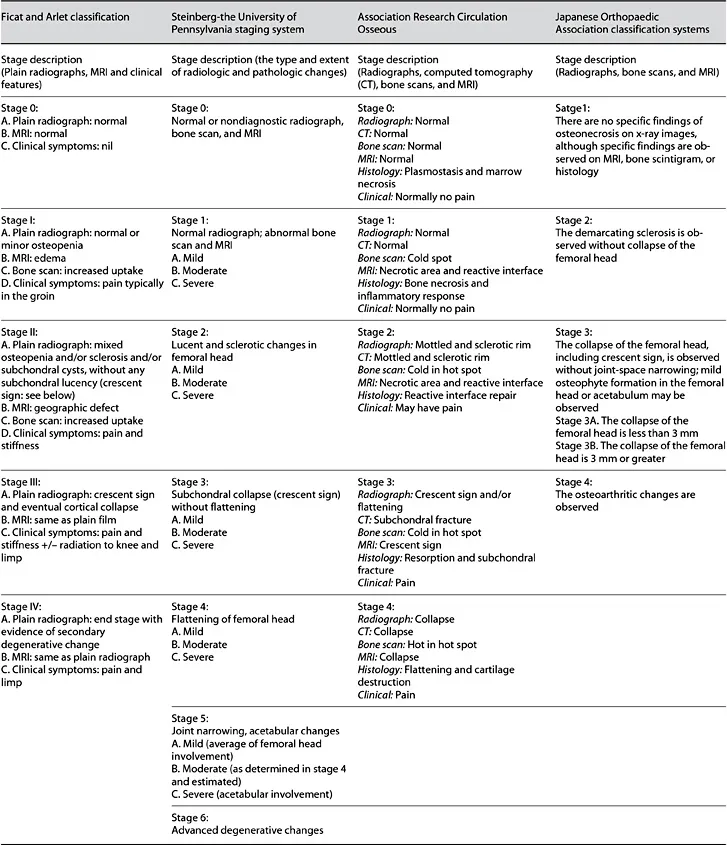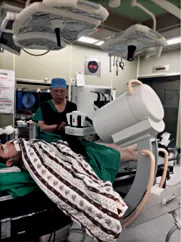![]()
Section II: Musculoskeletal Disorders
Wang C-J, Schaden W, Ko J-Y (eds): Shockwave Medicine.
Transl Res Biomed. Basel, Karger, 2018, vol 6, pp 17–26 (DOI: 10.1159/000485056)
______________________
Development of Extracorporeal Shockwave Therapy for Treatment of Osteonecrosis of the Femoral Head
Jai-Hong Chenga, c · Shan-Ling Hsua, b · Ching-Jen Wanga, b
aCenter for Shockwave Medicine and Tissue Engineering, bDepartment of Orthopedic Surgery, and cMedical Research, Kaohsiung Chang Gung Memorial Hospital and Chang Gung University College of Medicine, Kaohsiung, Taiwan
______________________
Abstract
Osteonecrosis of the femoral head (ONFH), also known as avascular necrosis of the femoral head, is usually caused by the death of bone tissue due to disruption of blood supply. Multiple factors can induce ONFH such as drug abuse alcohol overuse overweight, trauma, corticosteroid, chemotherapy, and idiopathic. Symptomatic hips with early ONFH are treated conservatively, while joint replacement is indicated in late stage. For early stages, core decompression with or without bone grafting is recommended to preserve the femoral head. However, the results are inconsistent. Some achieved limited success but none universal. Some reported poor results that many patients eventually undergo hip replacement surgery. Total hip replacement in young patients is at risk for loosening and dislocation. Other methods of treatment included non-weight-bearing therapy, hyperbaric oxygen therapy, and extracorporeal shockwave therapy (ESWT). ESWT has been used to treat various tendinopathies and fractures with poor bone healing with reasonable success for 30–40 years. Recently, ESWT was investigated in the treatment of ONFH. ESWT is a noninvasive device that exerts beneficial effects of improving bone regeneration, anti-inflammatory, pain relief, and angiogenesis in the treatment of ONFH. Many experiments showed that ESWT is more effective than core decompression with or without bone grafting for patients with early stage of ONFH. The purpose of the present article is to review the clinical trials and animal studies of ESWT on ONFH with perspective and challenge in the future.
© 2018 S. Karger AG, Basel
Osteonecrosis of the Femoral Head and Extracorporeal Shockwave Therapy
The etiology of osteonecrosis of the femoral head (ONFH) is multifactorial including alcohol abuse, overweight, trauma, corticosteroid usage, chemotherapy, thalassemia, pregnancy, HIV infection, organ transplantation, ischemia, systemic lupus erythematosus (SLE), and idiopathic [1, 2]. ONFH is usually progressive that leads to collapse or fracture of femoral head, and the disease finally leads to the femoral head collapse, destruction and degenerative changes of hip joint. Several prognostic factors could be observed for the progression of ONFH including the extent and location of the osteonecrotic lesion, lesion size, bone marrow edema in the proximal femur, and genetic factors [2, 3]. Imaging studies, particularly MRI, are the major methods that can accurately evaluate and assess the progression of ONFH. These imaging studies may also assess the risks of femoral head collapse from patients’ perspective and clarify the patient expectation from the perspective of the history of the natural development of the disease. There are several classification systems to identify and staging the ONFH, including Ficat and Arlet classification, Steinberg-the University of Pennsylvania staging system, Association Research Circulation Osseous (ARCO), and the Japanese Orthopaedic Association classification systems (Table 1) [4]. These classification systems provide information of ONFH on the prognosis and assist with treatment decision.
There are many options for treating ONFH including non-weight-bearing (NWB) therapy, pharmacologic treatment, physical support, hyperbaric oxygen (HBO) therapy, core decompression, extracorporeal shockwave therapy (ESWT), and surgery [5]. The purpose of treatment for ONFH is to prevent collapse or delay the stage progression of the femoral head. However, the optimal treatment for ONFH is still not well defined and remains controversial. In general, patients with early ONFH prefer conservative nonsurgical management, but unsatisfactory functional outcomes were noticed in most patients. There is still no completely effective method, even with regard to surgery for ONFH. Better results often rely on early diagnosis and treatment. The type of surgery is dependent on the stage of ONFH images [6, 7]. The operative treatment such as the core decompression with or without bone grafting is the most common surgical procedure for precollapse of ONFH and is regarded as the gold standard for preserving the femoral head. However, the potential risk included infections and immune response, and reports unsatisfactory results [8]. Recently, ESWT was reported effective by researchers in the treatment of ONFH [9–11]. This article describes a new effective and noninvasive method of ESWT for the treatment of ONFH.
ESWT for ONFH
Researchers reported that focused ESWT is effective in the treatment of ONFH [9–12]. However, the exact mechanism of ESWT in ONFH is still unknown. In 2001, Ludwig et al. [9] first reported ESWT treatment in 22 patients with ONFH of ACRO classification from stages 1–3 and were followed up for 1 year. The patients showed significant improvement in the visual analogue pain score, which decreased from 8.5 to 1.2. Harris hip score increased from 43.3 to 92 and the lesion size decreased or healed in 10 of 14 successfully treated patients. The therapeutic success rate was noticed in 14 patients, and 4 patients showed complete healing on MRI. Wang et al. [10] were the first to report that ESWT treated patients with ONFH by using FDA-approved machine OssaTron in Taiwan in 2005 (Fig. 1). They compared ESWT treatment in 23 patients (29 hips) with 25 patients (29 hips) receiving core decompression with nonvascularized fibular grafting with early stages of ONFH. The results showed significant improvement in pain and Harris hip scores (p < 0.001). There was a trend of reduction in the lesion size of ESWT group as compared to core decompression with fibular graft side on average follow-up of 25 months. In 2009, Chen et al. [13] compared the functional outcomes of ESWT on one side and total hip arthroplasty (THA) on the other hip in 17 patients with bilateral hip necrosis. The pain score and Harris hip score showed significant improvements after treatment (p < 0.001). A significant difference in the levels of improvement was observed between the 2 sides, with the difference favoring the ESWT side (p < 0.001). The results showed that 13 patients rated ESWT better than THA and only 4 patients reported comparable results between THA and ESWT and no one scored that THA was better than ESWT. At 1-year follow-up, of 36 patients with 42 hips with ONFH, the results showed 6 cases cured, 13 cases markedly improved, 16 cases improved, and 7 cases of failures [14].
Table 1. Classification systems of osteonecrosis of the femoral head
Fig. 1. A photograph showing shockwave treatment of ONFH by Professor Wang.
The long-term follow-up of ESWT for ONFH was reported by Dr. Vulpiani et al. [11] in 2012 . The ESWT for treatment of 36 patients with ONFH was followed up at 3, 6, 12, and 24 months. The results were significantly associated with ARCO staging of the lesions after ESWT. Patients with early stage ONFH with ARCO stage I (100%) and stage II (81.8%) achieved excellent or good results than those in their late phase with ONFH with ARCO stage IIIa (26.7%) at follow-up (p < 0.005). Kusz demonstrated that ESWT resulted in considerable enhancement of quality of life in ONFH patients. Patients experienced pain reduction (visual analogue pain score decreased from 6.75 to 2.5) and increased mobility of the treated hip joint. Harris hip score increased from 55.21 to 89.21. However, they only followed up patients for 6 weeks [15]. In the same year, Wang et al. [16] reported long-term results of ESWT and core decompression in ONFH with 8- to 9-year follow-up. There were 48 patients with 57 hips in the study. The ESWT group consisted of 23 patients with 29 hips and the core decompression group had 25 patients with 28 hips. The functional results showed that 76% of hips were good or fair and 24% were poor after ESWT. On the other hand, 21% of hips were rated good or fair and 79% poor after core decompression. The results demonstrated that ESWT had better results than surgery in the treatment of early ONFH in long-term follow-up. Similar results were reported by Lee et al. [17]. They evaluated 24 patients with ARCO-staged ONFH in 32 hip joints that were treated with ESWT and follow-up from 1993 to 2012. The visual analogue scale scoring in group 1 (ARCO stages I and II) showed a median of 7–1.5 (p < 0.001) and group 2 (ARCO stage III) showed a mean of 7 to 4 (p = 0.056). In Harris hip score (HHS) analysis, group 1 showed significant improvement from 65.5 to 95 (p < 0.001), but the improvement was non-significant for group II (p = 0.280). The results indicated that ESWT was effective in early and mid-stage of ONFH. The largest patient population on this topic was reported by Gao et al. [18]. They showed a total of 335 patients with 528 hips treated with ESWT and followed up at 3, 6, and 12 months. The pain reduction (p = 0.00006) improved mobility of the treated hips (p = 0.00091), and bone marrow edema (p = 0.007) showed significant improvement after ESWT. The lesion size decreased after ESWT, but the differences were nonsignificant. Wang et al. [19] demonstrated that high dosage ESWT was more effective in the treatment of early-stage ONFH. They recruited 32 patients (42 hips) randomly and divided them into three groups. Group A (10 patients with 16 hips) received 2,000 impulses of ESWT at 0.51...


